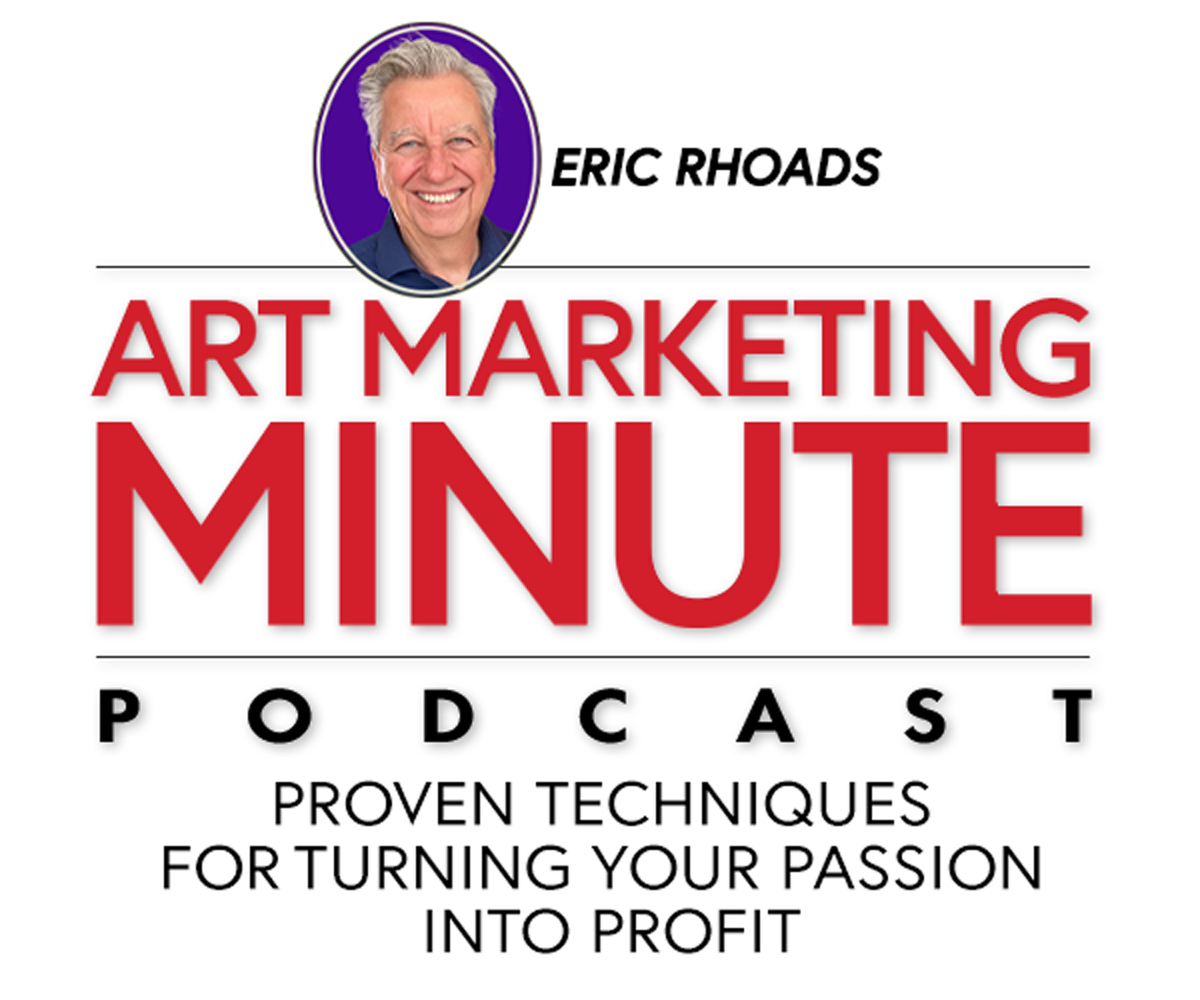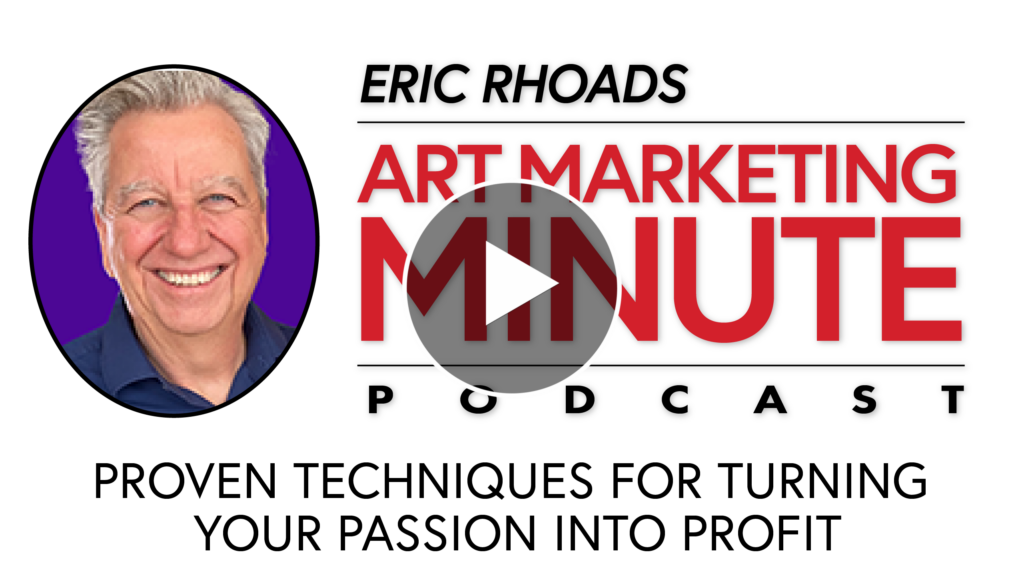In the Art Marketing Minute Podcast, you’ll learn how to sell your art, how to market your paintings, and everything else you need to know in order to have a successful art career. Each episode answers questions from artists by host Eric Rhoads, author of “Make More Money Selling Your Art,” publisher of several art magazines and newsletters, and author of ArtMarketing.com.
Do frames add value when selling a painting? What’s a good way to get into a coffee shop with your art? Eric Rhoads answers in this week’s Art Marketing Minute.
Listen to the Art Marketing Minute Podcast: Episode 71 >
Submit Your Art Marketing Question:
What questions do you have about selling your art? Email Eric today at [email protected] (include your name and where you’re from) to hear your question answered on an upcoming Art Marketing Minute Podcast.
FULL TRANSCRIPT of the Art Marketing Minute:
DISCLAIMER: The following is the output of a transcription from an audio recording of the Art Marketing Minute. Although the transcription is mostly correct, in some cases it is slightly inaccurate due to the recording and/or software transcription.
Announcer:
This is the Art Marketing Minute with Eric Rhoads, author of the Amazon best selling book, “Make More Money Selling Your Art.” In the marketing minute we answer your questions to help your art career brought to you by artmarketing.com, the place to go to learn more about marketing. Now, here’s your host, arts magazine publisher, Eric Rhoads.
Eric Rhoads:
And in the marketing minute I answer your art marketing questions you can email your questions to me [email protected]. Here’s a question from David Bailey in Richmond, Kentucky who asked do frames add value. When selling a painting? Well, let me give you a story. I won’t mention names. But I was on the phone with a dealer. And this dealer told me the story about how he had this painting that had been sitting in the gallery for a year and it just hadn’t sold. He said it was a really good painting, I moved it around a lot. It still didn’t sell. And I was getting ready to I took it off the wall, I was getting ready to send it back to the artist. And I thought you know, it’s really too good of a painting. So he, he took it to his framer, he’s got a really high end framer, he said, I think the problem is the frame. So they put a really high quality frame on it. And he put it up on the wall, and he raised the price by triple, triple now it was an expensive frame, but he raised the price higher. And he said that painting sold in the first week now, do frames help. I mean, you know, when you’re driving down the road, and you see somebody at a Porsche 911 or a Bentley, you know, if they send a signal about that person, you know, maybe. So I think that, you know, you look at it at the environment frames do make a huge difference. We have a lot of great framers who advertise in plein air magazine, you can look in there for frame ideas. And you know, frames don’t necessarily have to be really expensive, some really expensive frames exist. And they’re, you know, they’re almost always worth it. But there are also some really beautiful frames that are not super expensive, but frames make a difference. And I like the idea of the artists controlling the framing, because you want to make sure that you are setting the experience properly. I mean, you spend all this time on a beautiful painting, and then you send it out to somebody and they slap it in a frame now if they want to change it later, but to help sell it, I think, you know, the frame matters. I have a beautiful framed painting from David Lafell. And he made the frame himself and it just is a perfect fit any other frame would have not fit. So I think framing is critical. David, I would put a lot of value into that. And a friend of mine was having an art show and he was kind of new at this and he was struggling with the idea of expensive frames. And I said to him, Look, I you know, go for it, spend the money, you’ll never regret it. And I said and you’ll be able to get a higher price. And he said, you know, it’s really hard to do because I don’t have the money. And I said I get that. Well, he he did it. And he didn’t do it completely. But he did it. And the ones that had the better frames outsold the ones that didn’t have the better frames and he got a higher price for him. So just saying I think frames make a huge difference.
Now here’s a question from Mary Ann Carnes who asked I don’t know where she’s from. Make sure you tell us when you send in your email tell us where you’re from. Mary Ann says what’s a good way to get into a coffee shop with your art? And what’s a fair percentage split? Well, I think the question Maryann is, why do you want to be in a coffee shop? I mean, you know, we all go into coffee shops, and it’s not unusual to see art hanging in coffee shops, and art for sale hanging in coffee shops, and is that really the best place for you to be? Now, I like the idea of getting some experience. I like the idea of getting out there and trying something. But you know, a coffee shop, you’re battling a lot of other distractions. And you know, it’s kind of embarrassing, if there’s a painting the like you’re walking by it, but it’s over somebody’s booth, you’re not gonna walk up and get the information on it. And so, you know, it’s a tough environment. now. I’ll go ahead and answer that question. But I think you should also be considering, is there a better environment for my work? Maybe, maybe there is. And I would think, you know, as John Coleman was talking about, you know, being the best you can be and having the mindset of maybe you’re telling yourself a coffee shop is all you can get when in fact, you can get into a gallery that’s worth considering, ask yourself that question. But Maryann, if you want to get into a coffee shop, I just take a portfolio of your work and one or two originals. And what I would do, this is not what everybody would do. But I’d take a nice small painting and I’d, I’d call it I say I have a call the owner, I say have a gift for you. And I want to discuss your business proposition. And so you take a gift in and you give them a nice painting a small one, I wouldn’t give them a very expensive one. But just give them a small painting and say, Listen, I would love here’s a gift for me, thanks for taking the meeting. Here’s a you know, this is I’m a painter, here’s what I do, here’s some of my work and show them some of your work. And I would love to have a show in your coffee shop or your restaurant because I think your people would like it. And it might help me a little bit. And of course, it’ll help you to please accept this gift. And you know, they’ll probably put you in, they’ll probably give you a show, instead of a coffee shop, what I would do is I would go for a high end restaurant, depending on the quality of your work. But I frame it up really nicely, I’d make sure by the lobby area, there’s kind of a listing of paintings. And there’s a way to get a brochure or something, but also a couple paintings right by the lobby area. And ask the owner if you can rotate them once a week or something because people go back to restaurants, if they’re in a high end restaurant, and they’re spending a couple 100 bucks for a meal, and they’ve had a couple of bottles of wine, you’ve got a really nice likelihood that they’re going to fall in love with your work. And then it just got to make you got to figure out a way to make it easy for them to buy. So one of the things you can do is you can put one of these little scan codes on each one and say scan this and it’ll tell you to bring up the painting. The other thing is to make an arrangement with the owner so that they can actually sell it right then and there. Because if people leave, and then they’re, you know, their enthusiasm wanes, you know, they might not call you they might not go to your website. So make it easy to say to the owner, look, I’m going to give you a percentage. And, you know, so what’s a fair percentage split, you know, in a typical gallery relationship, it’s about 50/50. Some artists, it’s 40/60. Because the galleries you know, if you’re a better more well known artists, galleries won’t take as much of a percentage. You know, what you’re trying to do here is to get some experience or trying to get good at this, I think 50/50 is very fair. And you know, the if it’s got to be worthwhile for the business owner, because if they say, Hey, I’m gonna make 500 extra bucks, you know, somebody’s painting, sell, you know, then make it easy for them. And it’s just but you’ve got to make sure they know how they know how to do this and how to make the paintings available. And you know, they can take them right there with them. And you know, that all that kind of stuff. So you just have to go through that with them.
Well, this has been the art marketing minute with me. Eric Rhoads. My goal in life is to eliminate the idea of the starving artist to help your dreams actually come true. So if you want to submit questions, simply email [email protected]. And to learn more about marketing ideas, you can visit Artmarketing.com. Thanks for listening.
How to Submit Your Art Marketing Questions: What questions do you have about selling your art? Email Eric today at [email protected] (include your name and where you’re from) to hear your question answered on an upcoming Art Marketing Minute Podcast.



Leave A Comment